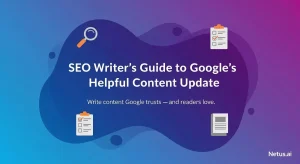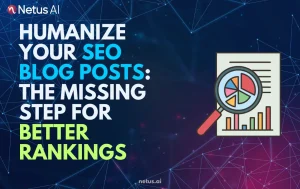
Why Google’s ‘Who, How, Why’ Framework Matters for EEAT | NetusAI
Why Google’s ‘Who, How, Why’ Framework Matters for EEAT AI can create articles in seconds. But here’s the truth: speed is not enough. Google wants
How and Why to Avoid Duplicate Content: A Comprehensive Guide

Content writer and editor for Netus.AI
How and Why to Avoid Duplicate Content. Ensuring the uniqueness of website content is crucial as duplicate content can adversely affect a website’s ranking in search results. Creating original content not only helps to engage the audience, but also avoids potential penalties due to plagiarism. However, duplicate content may unintentionally occur when multiple web addresses are created for the same site or webpage. This confounds search engines, leading to issues with search results and website ranking.
As users search for information online, search engines use algorithms to scan and display websites, blogs, or social pages corresponding to the users’ search terms. When identical information is present on various platforms, search engines typically choose to display only one result, often ignoring the others. Consequently, websites with duplicate content may experience decreased traffic and a lower ranking.
To address this issue, it is essential to employ a duplicate content checker tool for systematically detecting duplicated content and ensuring the integrity of a website. There are numerous tools available to help with this task, each with its unique features and capabilities. Some popular examples include Copyscape, Siteliner, Grammarly, and Screaming Frog.
These tools aid in identifying instances of scraped content that may have been taken from other sites by content scrapers. Using Google Alerts can also assist in monitoring potential instances of scraped content and take appropriate action when necessary.
By incorporating a duplicate content checker tool into your workflow, you can safeguard your website against the negative consequences of duplicate content. Being proactive about avoiding plagiarism and maintaining unique content will ultimately contribute to a better overall online presence, improved search engine ranking, and greater user engagement.
Utilizing these tools and strategies can effectively combat plagiarism, content scrapers, and other duplicate content issues, ensuring a strong and consistent web presence in the digital landscape.
Dealing with duplicate content issues is crucial to ensure optimal website performance, as various technical problems may cause websites to result in duplicated versions. This issue frequently arises from language changes or device adaptability. Although these problems do not lead to search engine penalties, they can cause traffic to be directed to non-preferred versions of the website, resulting in lowered rankings.
It is imperative to resolve these technical issues, as they consume the website owner’s crawl budget, further diluting the website’s rank. Properly addressing duplicate content ensures website optimization and an improved user experience.
A website’s performance hinges heavily on its user experience. Subpar websites containing stale content fail to retain visitors’ attention. Conversely, well-built websites attract significant traffic. Therefore, if there is a sudden decrease in search volume, it is essential to examine the potential causes.
Regrettably, many low-quality websites resort to plagiarizing content from more reputable sites. Scraping content from other sources can negatively impact the original site, as search engines may recognize the content as duplicate. Consequently, this affects the site’s reliability and placement on search engine results pages.
To protect website ranking and uphold content integrity, it is crucial to address duplicate content issues quickly. In cases of content theft, it is vital to report the situation to appropriate forums that handle such infractions.
By identifying and resolving duplicate content issues, website owners can maintain their search engine rankings while ensuring a top-quality experience for their visitors and protecting their original content from damaging effects of plagiarism.
To maintain the originality and uniqueness of your website content, it is crucial to avoid the duplication of content. By addressing several common issues, you can effectively prevent duplicate content and its negative impact on your website’s SEO. Here are some key steps to follow:
By addressing these aspects and implementing the suggested solutions, you can effectively minimize content duplication and its negative impact on your website’s SEO performance. A well-structured content strategy, coupled with regular site audits and resolving technical issues, will ensure your website remains unique and authoritative, ultimately enhancing the overall user experience and search engine rankings.
Duplicate content can negatively impact your website’s SEO performance since it creates confusion for search engines, making it difficult to determine which version of the content should be shown in search results. Consequently, this can lead to lower rankings and traffic. According to Moz, duplicate content occurs when identical content appears at multiple web addresses.
To prevent duplicate content issues, consider the following strategies:
Unique content is essential for search engine rankings because it helps search engines identify your website as a valuable and authoritative source of information. This leads to improved rankings and increased visibility, which attracts more traffic and enhances your website’s overall SEO performance. Original content also provides a better user experience, encouraging visitors to spend more time on your site and engage with your content.
To tackle duplicate content issues across multiple domains, consider these best practices:
Canonical tags, or rel=”canonical” tags, are used to specify the preferred version of a page when multiple versions with similar content exist. By implementing these tags, you inform search engines which version should be indexed and displayed in search results—addressing duplicate content issues and preventing potential ranking penalties. Here’s a comprehensive guide on how to use canonical tags.
While there is no specific percentage, it’s essential to keep the amount of duplicate content on your website as minimal as possible, ideally zero. However, small instances of duplicate content, such as short quotes or legally required disclosures, are unlikely to cause significant issues. Focus on producing unique and high-quality content throughout your website as a way to improve your SEO performance.

Why Google’s ‘Who, How, Why’ Framework Matters for EEAT AI can create articles in seconds. But here’s the truth: speed is not enough. Google wants

SEO Writer’s Guide to Google’s Helpful Content Update Keeping up with Google’s algorithm changes can feel like a relentless game of whack-a-mole. Just when you

Can AI Content Be Safe for SEO in 2025? Let’s start with the question of keeping every content strategist, SEO pro and blogger awake at

Humanize Your SEO Blog Posts: The Missing Step for Better Rankings You’ve done everything by the book. Your keyword research is impeccable. Your meta descriptions

How to Pass AI Detection Tests as an SEO Writer Let’s paint a familiar picture. You’ve just finished a blog post. The headline is sharp,

Why Your AI SEO Blog Isn’t Ranking (And How to Fix It) You embraced AI for your blog. The promise was intoxicating: high-quality content, published
@ 2024 Netus AI.